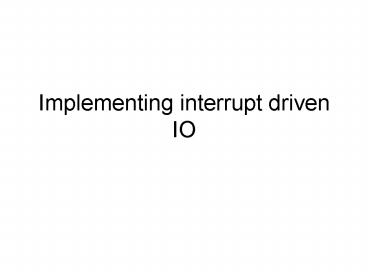Implementing interrupt driven IO - PowerPoint PPT Presentation
Title:
Implementing interrupt driven IO
Description:
They write to internal operating system buffers. These buffers are in ... In Unix/Linux these are called IOCTL calls. For example. stty -raw ... – PowerPoint PPT presentation
Number of Views:35
Avg rating:3.0/5.0
Title: Implementing interrupt driven IO
1
Implementing interrupt driven IO
2
Why use interrupt driven IO?
- Positive points
- Allows asynchronous operation of IO events
- Good use of resources
- Leads to modular structure of system
- Leads to better response times for interactive
tasks
- Negative points
- It is harder to program
- Leads to more complex code and system
- Can be difficult to debug errors
- Could have security implications
3
Hardware resources required
- We will need a processor which can accept
interrupts - A serial port module that can generate interrupts
- A priority scheme would be useful
- At least bi-modal processor at least supervisor
and user modes
4
The 68307 Serial module
5
UART Mode Register 1
- RxIRQReceiver Interrupt Select
- 1 FFULL is the source that generates IRQ.
- 0 RxRDY is the source that generates IRQ.
6
UART Interrupt Status Register
- RxRDYReceiver Ready or FIFO Full
- The function of this bit is programmed by UMR1
bit 6. It is a duplicate of either the FFULL or
RxRDY bit of USR. - TxRDYTransmitter Ready
- This bit is the duplication of the TxRDY bit in
USR. - 1 The transmitter holding register is empty and
ready to be loaded with a character. - 0 The transmitter holding register was loaded
by the CPU, or the transmitter is disabled. - Characters loaded into the transmitter holding
register when TxRDY0 are not transmitted.
7
UART Interrupt Mask Register
- FFULLFIFO Full
- 1 Enable interrupt
- 0 Disable interrupt
- TxRDYTransmitter Ready
- 1 Enable interrupt
- 0 Disable interrupt
8
UART Interrupt Vector Register
- IVR7IVR0Interrupt Vector Bits
- This 8-bit number indicates the offset from the
base of the vector table where the address of the
exception handler for the specified interrupt is
located. The UIVR is reset to 0F, which
indicates an uninitialized interrupt condition.
9
(D)UART ISR CODE
10
(No Transcript)
11
(No Transcript)
12
Library and System IO calls
- Library and system IO calls do not write to the
IO devices. They write to internal operating
system buffers. - These buffers are in
- User space for library buffers fprintf etc
- In system space for system calls write, read
etc - This allows processes to read and write data
off-line from peripherals
13
IOCTL or IO control functions
- As there is a separation between the calls that
handle the hardware and handle the data buffers,
the operating system can process the data quite
easily running a series of control functions on
the data. - In Unix/Linux these are called IOCTL calls. For
example - stty -raw
14
Writing data from user space to a device
User Space
System/kernel space
Printf
Write
Sys_write
Printf data
D A T A
D A T A
D A T A
DEVICE
Buffer
Buffer
IOCTL Functions
15
Connecting Processes with their IO
- In multi-tasking and multi-user systems there are
a number of users and processes waiting to send
or receive data. - The operating systems must make sure that they
get their correct data or that it goes to the
correct resource - This is handled by the scheduler and IO manager
modules.































